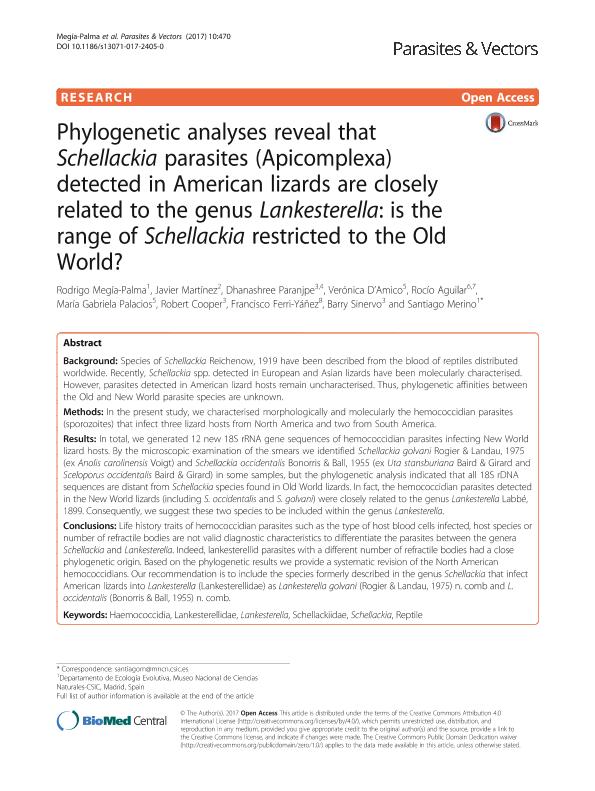Mostrar el registro sencillo del ítem
dc.contributor.author
Megía Palma, Rodrigo
dc.contributor.author
Martínez, Javier
dc.contributor.author
Paranjpe, Dhanashree
dc.contributor.author
D'amico, Veronica Laura

dc.contributor.author
Aguilar, Rocío

dc.contributor.author
Palacios, María Gabriela

dc.contributor.author
Cooper, Robert
dc.contributor.author
Ferri Yáñez, Francisco
dc.contributor.author
Sinervo, Barry Raymond

dc.contributor.author
Merino, Santiago
dc.date.available
2018-04-24T21:11:46Z
dc.date.issued
2017-10
dc.identifier.citation
Megía Palma, Rodrigo; Martínez, Javier; Paranjpe, Dhanashree; D'amico, Veronica Laura; Aguilar, Rocío; et al.; Phylogenetic analyses reveal that Schellackia parasites (Apicomplexa) detected in American lizards are closely related to the genus Lankesterella: is the range of Schellackia restricted to the Old World?; BioMed Central; Parasites and Vectors; 10; 470; 10-2017; 1-10
dc.identifier.issn
1756-3305
dc.identifier.uri
http://hdl.handle.net/11336/43401
dc.description.abstract
Background: Schellackia species have been described from the blood of reptiles distributed worldwide. Recently, Schellackia species detected in European and Asian lizards have been molecularly characterized. However, parasites detected in American host lizards remain uncharacterized. Thus, phylogenetic affinities between Old and New World parasite species are unknown.Methods: In the present study, we have morphologically and molecularly characterized hemococcidian parasites (sporozoites) that infect three lizard hosts from North America and two from South America.Results: In total, we achieved 12 new 18S rDNA gene sequences of hemococcidian parasites infecting New World lizard hosts. On the one hand, by the microscopic examination of the smears we identified Schellackia golvani (ex Anolis carolinensis) and Schellackia occidentalis (ex Uta stansburiana and Sceloporus occidentalis) in some samples, but the phylogenetic analysis indicates that all 18S rDNA sequences are distant from Schellackia species found in Old World lizards. In fact, the hemococcidian parasites detected in New World lizards (including S. occidentalis and S. golvani) were closely related to genus Lankesterella. Consequently, we suggest these two species to be included within the genus Lankesterella.Conclusions: Life history traits of hemococcidian parasites such as type of host blood cell infected, host species or number of RB were not valid diagnostic characteristics to differentiate the parasites between the genera Schellackia and Lankesterella. Indeed, lankesterellid parasites with different number of refractile bodies had close phylogenetic origin. Based on the phylogenetic results we suggest a systematic revision of the American hemococcidia. Our recommendation is to include the species formerly described in genus Schellackia (i.e., S. golvani and Schellackia occidentalis) that infect American lizard into genus Lankesterella (Lankesterellidae).
dc.format
application/pdf
dc.language.iso
eng
dc.publisher
BioMed Central

dc.rights
info:eu-repo/semantics/openAccess
dc.rights.uri
https://creativecommons.org/licenses/by-nc-sa/2.5/ar/
dc.subject
Haemococcidia
dc.subject
Lankesterellidae
dc.subject
Reptile
dc.subject
Schellackiidae
dc.subject.classification
Otras Ciencias Biológicas

dc.subject.classification
Ciencias Biológicas

dc.subject.classification
CIENCIAS NATURALES Y EXACTAS

dc.title
Phylogenetic analyses reveal that Schellackia parasites (Apicomplexa) detected in American lizards are closely related to the genus Lankesterella: is the range of Schellackia restricted to the Old World?
dc.type
info:eu-repo/semantics/article
dc.type
info:ar-repo/semantics/artículo
dc.type
info:eu-repo/semantics/publishedVersion
dc.date.updated
2018-04-05T18:24:48Z
dc.journal.volume
10
dc.journal.number
470
dc.journal.pagination
1-10
dc.journal.pais
Reino Unido

dc.journal.ciudad
Londres
dc.description.fil
Fil: Megía Palma, Rodrigo. Consejo Superior de Investigaciones Científicas; España
dc.description.fil
Fil: Martínez, Javier. Universidad de Alcalá; España
dc.description.fil
Fil: Paranjpe, Dhanashree. University of California; Estados Unidos. Abasaheb Garware College; India
dc.description.fil
Fil: D'amico, Veronica Laura. Consejo Nacional de Investigaciones Científicas y Técnicas. Centro Científico Tecnológico Conicet - Centro Nacional Patagónico. Centro para el Estudio de Sistemas Marinos; Argentina
dc.description.fil
Fil: Aguilar, Rocío. Consejo Nacional de Investigaciones Científicas y Técnicas. Centro Científico Tecnológico Conicet - Mendoza. Instituto Argentino de Investigaciones de las Zonas Áridas. Provincia de Mendoza. Instituto Argentino de Investigaciones de las Zonas Áridas. Universidad Nacional de Cuyo. Instituto Argentino de Investigaciones de las Zonas Áridas; Argentina. University of Melbourne; Australia
dc.description.fil
Fil: Palacios, María Gabriela. Consejo Nacional de Investigaciones Científicas y Técnicas. Centro Científico Tecnológico Conicet - Centro Nacional Patagónico. Centro para el Estudio de Sistemas Marinos; Argentina
dc.description.fil
Fil: Cooper, Robert. University of California; Estados Unidos
dc.description.fil
Fil: Ferri Yáñez, Francisco. Consejo Superior de Investigaciones Científicas; España
dc.description.fil
Fil: Sinervo, Barry Raymond. University of California; Estados Unidos
dc.description.fil
Fil: Merino, Santiago. Consejo Superior de Investigaciones Científicas; España
dc.journal.title
Parasites and Vectors

dc.relation.alternativeid
info:eu-repo/semantics/altIdentifier/doi/http://dx.doi.org/10.1186/s13071-017-2405-0
dc.relation.alternativeid
info:eu-repo/semantics/altIdentifier/url/https://parasitesandvectors.biomedcentral.com/articles/10.1186/s13071-017-2405-0
Archivos asociados
